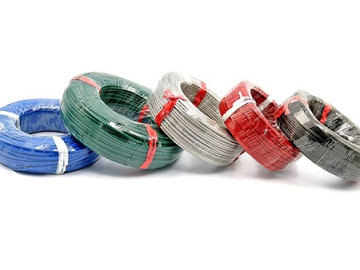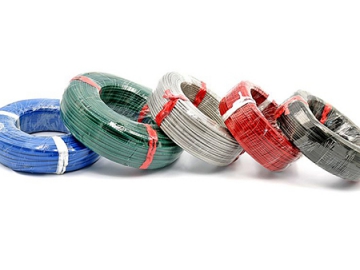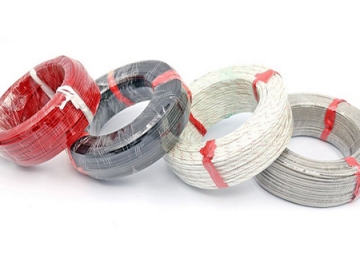Compensating Cables, Thermocouple Extension Wires
Shenzhuan compensating cables & thermocouple extension wires are generally used for the transmission of thermoelectric voltage from thermocouple to cold junction. As you can see, there are different types of thermocouples. The various metal pairings and their measurement accuracy are specified in IEC standard 584-3. Furthermore, the operating temperature of the compensation cable is almost equal to the operating range of PVC. And the insulation and sheath materials of this thermocouple compensation cable are made from PVC and quality fluoroplastics, thus providing excellent resistance against moisture, abrasion and flame. Therefore, the PVC and quality fluoroplastics are the insulation material used for covering the thermocouple compensation cable. In fact, insulation and jacket by fluoropolymers, silicon rubber, thermoplastic compounds, are particularly suitable for indoor and outdoor use.
Due to the different applications as for example in smelteries, cold stores or in liquid gas systems where always a reliable and safe transmission of the occuring thermoelectric voltage in mV must be ensured. In order to compensate for errors in the temperature changes at their junction with the thermocouple, this compensating cable is usually connected with the thermocouples and measuring devices.
Different types of thermocouples are classified according to their characteristics. As we know, the most widely used types of thermocouples are: J, K, E & T. Here, I would like to briefly introduce the two most frequently used types at this point, which are type K thermocouple and type J thermocouple.
The compensating wires and strands are identified with the letter "C" adapted to DIN IEC 584. The "C" appears behind the code letter identifying the thermocouple, for example "KC". Type K thermocouple is the most widely used thermocouple among all types of thermocouples. It has the highest temperature range.
As a cheaper and the most commonly used thermocouple, the type J thermocouple's temperature range is between -190℃ to 760℃. This temperature range and the life span of the J-type thermocouple are less than the K-type thermocouple. However, a J-type thermocouple is most suited for the oxidizing atmospheres.
Technical Data| Insulation and sheath | Temperature range (℃) | |
| Material | Code letter | |
| Polyvinyl chloride (PVC) | V | -20~100℃ |
| Alkali-free glass fiber filament | B | -25~200℃ |
| Fluoroplastics | F | -25~200℃ |
| Code letter | General-purpose (G) | Heat resistance (G) | ||
| General grade | Sophisticated grade (S) | General grade | Sophisticated grade (S) | |
| S | SC-G | SC-GS | SC-H | -- |
| N | NC-G | NC-GS | NC-H | NC-HS |
| K | NC-G | NC-GS | NC-H | -- |
| KC2-G | KG2-GS | KC2-H | KC2-HS | |
| KX-G | KX-GS | KX-H | KX-HS | |
| E | EX-G | EX-GS | EX-H | EX-HS |
| J | JX-G | JX-GS | JX-H | JX-HS |
| T | TX-G | TX-GS | TX-H | TX-HS |
| Application | Code letter | Color | |
| General grade | Sophisticated grade | ||
| General-purpose | G | (Black) | S (Gray) |
| Heat resistance | H | (Black) | S (Gray) |
| Type of thermocouple | Thermocouple grade | Compensation cable | Color | ||
| Positive lead | Negative lead | Positive lead | Negative lead | ||
| SC | S (Chromium alloy10-Platinum) | SPC(Copper) | SNC (Copper-Nickel) | Red | Green |
| NC | N (Nickel-silicon) | NPC(Iron) | NNC (Copper-Nickel) | Red | Yellow |
| KC | K (Copper-Constantan) | KPC(Copper) | KNC (Copper) | Red | Blue |
| KX | K (Chromium-Nickel, Nickel-Silicon) | KPX(Chromium-Nickel) | KNX (Copper-Nickel) | Red | Black |
| EX | E (Chromium-Nickel, Copper-Nickel) | EPX(Chromium-Nickel) | ENX (Copper-Nickel) | Red | Brown |
| JX | J (Iron, Copper-Nickel) | JPX(Iron) | JNX (Copper-Nickel) | Red | Purple |
| TX | T (Copper-Nickel) | TPX(Copper) | TNX (Copper-Nickel) | Red | White |
| Type | Compensation | Extension | |||||||
| SC | KC, NC | KX, NX | EX | JX | TX | ||||
| Thermocouple | S, R | K, N | K, N | E | J | T | |||
| Material and color | Positive lead | Material | Copper | Copper | Chromium-Nickel | Chromium-Nickel | Iron | Copper | |
| Color | Red | Red | Red | Red | Red | Red | |||
| Negative lead | Material | Copper-Nickel | Copper-Nickel | Nickel-Silicon | Copper-Nickel | Copper-Nickel | Copper-Nickel | ||
| Color | Green | Blue | Black | Brown | Purple | White | |||
| Range | (Sophisticated grade) | 100℃ | ±0.023 (3℃) | ±0.063 (1.5℃) | ±0.063 (1.5℃) | ±0.102 (1.5℃) | ±0.081 (1.5℃) | ±0.023 (0.5℃) | |
| 200℃ | ±0.060 (1.5℃) | ±0.111 (1.5℃) | ±0.083 (1.5℃) | ±0.027 (0.5℃) | |||||
| B (General grade) | 100℃ | ±0.037 (5℃) | ±0.105 (2.5℃) | ±0.105 (2.5℃) | ±0.170 (2.5℃) | ±0.135 (2.5℃) | ±0.047 (1.0℃) | ||
| 200℃ | ±0.057 (5℃) | ±0.100 (2.5℃) | ±0.183 (2.5℃) | ±0.138 (2.5℃) | ±0.053 (1.0℃) | ||||
| Resistance | Length:1meter at 20℃ Surface area: 1mm2 | <0.1Ω | <0.8Ω | <1.5Ω | <1.5Ω | <0.8Ω | <0.8Ω | ||
| Surface area (mm2) | 0.2, 0.5, 1.0, 1.5, 2.5 | ||||||||
| Strands | 1, 7, 19 | ||||||||
| Insulation and sheath materials, temperature | G (General purpose) | V.V,-20~70℃ and -20~100℃; | |||||||
| H (Heat resistance) | B.B,-40~180℃ and -25~200℃ F.B,-40~180℃ and -25~200℃ | ||||||||




